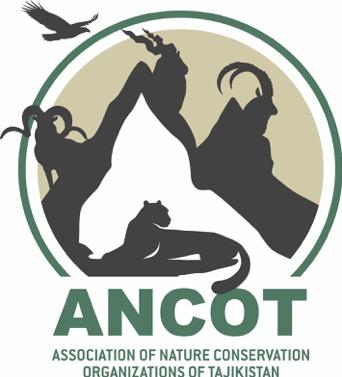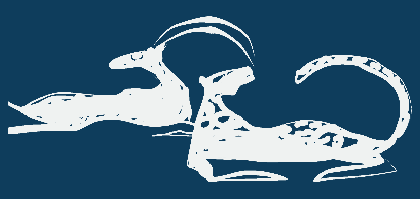Healthy Prey in Central Asia
The future of snow leopards relies on a landscape rich in healthy wild ungulate prey
The vast mountains and alpine pastures of Central Asia are home to a suite of wild sheep and goat species that play crucial roles in the high-altitude ecosystem. Each species is characterized by distinctive horns — the thick coil of the argali sheep, the sweeping scimitar of the Siberian ibex, and the screw-thread spiral of the markhor. These wild mountain ungulates represent the primary prey resource for the quintessential high elevation predator, the snow leopard. They are also part of the diets of wolves, brown bears, and scavengers like bearded and Himalayan vultures. It is this keystone position in the food web that makes these mountain ungulates so essential to the health of the ecosystem, with the loss of snow leopards and other predators an inevitable consequence wherever their numbers decline.
Disease Outbreaks and Mortality
Disease outbreaks and heavy mortality are commonly reported for mountain ungulates across Central Asia. Among the important infectious disease threats, Peste des Petits Ruminants virus is a particular cause for concern. This highly infectious pathogen leads to significant mortality, and has been spreading across Central Asia, with devastating wildlife outbreaks reported from Iran to Mongolia. Another important disease is contagious caprine pleuropneumonia, caused by Mycoplasma capricolum capripneumoniae, implicated in the death of at least 64 markhor in Tajikistan in 2010. Reports of parasitic disease are also widespread, with wildlife managers observing sarcoptic mange (caused by a skin mite) annually in ibex throughout their range. Interpreting the significance of outbreak reports is always a challenge, with many cases remaining undiagnosed (nevermind undetected) in these remote and inaccessible landscapes that often lack veterinary infrastructure. Understanding how these pathogens impact the viability of mountain ungulate populations requires us to piece together numerous threads of evidence, improving outbreak detection and diagnosis, assessing population exposure, and determining the outcome of infections including both overt mortality and more insidious effects like reduced breeding success. Assessing how domestic sheep and goats contribute to disease ecology and their role (if any) in pathogen transmission to wildlife is also essential to the design of strategies to manage those pathogens of greatest concern to mountain ungulate populations.
Forging New One Health Partnerships
Answering these questions requires the creation of new partnerships, combining distinct skills and expertise in ecology, wildlife management and veterinary medicine. In Central Asia’s Kyrgyz Republic, we are working with rangers with the Department for Biodiversity, Conservation and Protected Areas of the State Agency of Environment and Forestry who are often the first to detect changes in the health of the wildlife they manage. By connecting them with veterinarians with the Kyrgyz Research Institute of Veterinary named after A. Duysheev of the Ministry of Education and Science, they gain access to expertise in disease diagnostics and advanced laboratory resources. Despite their complementary interests, these agencies have traditionally worked in isolation from each other, but these new partnerships contribute to each of their mandates and a more complete understanding of wildlife and health in these challenging and inaccessible environments.
Low Tech Solutions to Remote Area Sampling
We adopt novel approaches when collecting diagnostic samples from wildlife in remote and hard to reach areas. Assessing a population’s pathogen exposure requires blood samples that are used to detect antibodies released by the immune system to fight specific infections. Conventional approaches that require electricity for sample processing and bulky methods of cold storage are impractical in the high mountain passes. Our low-tech solution to address this preserves blood by placing it on filter papers that then air dry— a technique that can be easily carried out by wildlife rangers when handling dead animals. This method stabilizes samples without the need for specialized equipment or refrigeration, and they can be reconstituted later in the laboratory to test for evidence of the animal’s exposure to a range of pathogens. Over time, this strategy will enable us to: 1) identify the pathogens that represent the greatest risks to local wild ungulates, 2) determine specific geographical areas where disease exposure is most intense, and 3) assess temporal trends in pathogen circulation.
Future Directions
As our understanding of disease exposure develops for these populations, our aim is to focus-in on those pathogens that represent the greatest threat to their viability as a step toward identifying approaches to disease control. This research, to be led by Kyrgyz doctoral or postdoctoral scientists, will allow us to compile a detailed epidemiological picture of key pathogens while investing in the future of wildlife health professional capacity in the country. We anticipate expanding our collaboration with state agencies to conduct more thorough investigations of outbreak incidents, equipping staff to respond quickly and safely to reports as they occur. Ultimately, we intend to expand these collaborations to neighboring countries facing similar issues with their own mountain ungulates. Only through communication and collaboration can we hope to understand the disease ecology of these critically important ungulate species and secure their place in the land of the snow leopard.













